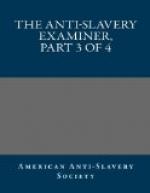The following is from Niles’ Weekly Register, published at Baltimore, Md. vol. 35, p. 4.
"Dealing in slaves has become a large business; establishments are made in several places in Maryland and Virginia, at which they are sold like cattle; these places of deposit are strongly built, and well supplied with thumb-screws and gags, and ornamented with cow-skins and other whips oftentimes bloody.”
R.S. FINLEY, Esq., late General Agent of the American Colonization Society, at a meeting in New York, 27th Feb. 1833, said:
“In Virginia and other grain-growing slave states, the blacks do not support themselves, and the only profit their masters derive from them is, repulsive as the idea may justly seem, in breeding them, like other live stock for the more southern states.”
Rev. Dr. GRAHAM, of Fayetteville, N.C. at a Colonization Meeting, held in that place in the fall of 1837 said:
“He had resided for 15 years in one of the largest slaveholding counties in the state, had long and anxiously considered the subject, and still it was dark. There were nearly 7000 slaves offered in New Orleans market last winter. From Virginia alone 6000 were annually sent to the south; and from Virginia and N.C. there had gone, in the same direction, in the last twenty years, 300,000 slaves. While not 4000 had gone to Africa. What it portended, he could not predict, but he felt deeply, that we must awake in these states and consider the subject.”
Hon. PHILIP DODDRIDGE, of Virginia, in his speech in the Virginia Convention, in 1829, [Debates p. 89.] said:—
“The acquisition of Texas will greatly enhance the value of the property, in question, [Virginia slaves.]”
Hon C.F. MERCER, in a speech before the same Convention, in 1829, says:
“The tables of the natural growth of the slave population demonstrate, when compared with the increase of its numbers in the commonwealth for twenty years past, that an annual revenue of not less than a million and a half of dollars is derived from the exportation of a part of this population.” (Debates, p. 199.)
Hon. HENRY CLAY, of Ky., in his speech before the Colonization Society, in 1829, says:
“It is believed that nowhere in the farming portion of the United States, would slave labor be generally employed, if the proprietor were not tempted to RAISE SLAVES BY THE HIGH PRICE OF THE SOUTHERN MARKET WHICH KEEPS IT UP IN HIS OWN.”
The New Orleans Courier, Feb. 15, 1839, speaking of the prohibition of the African Slave-trade, while the internal slave-trade is plied, says:
“The United States law may, and probably does, put MILLIONS into the pockets of the people living between the Roanoke, and Mason and Dixon’s line; still we think it would require some casuistry to show that the present slave-trade from that quarter is a whit better than the one from Africa. One thing is certain—that its results are more menacing to the tranquillity of the people in this quarter, as there can be no comparison between the ability and inclination to do mischief, possessed by the Virginia negro, and that of the rude and ignorant African.”




